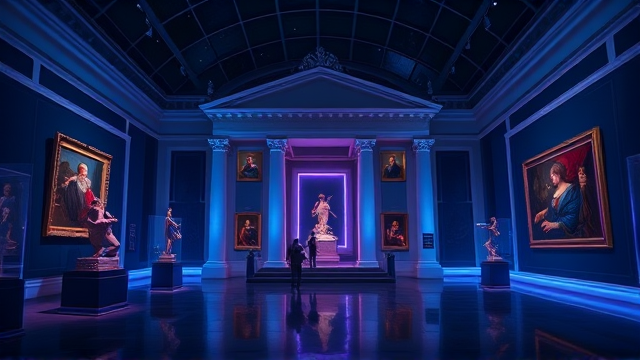Hispanic Society Museum Sells Old Master Paintings for Funds
In a move that echoes the quiet, necessary revolutions happening in cultural institutions worldwide, New York's Hispanic Society Museum & Library is undertaking a significant deaccessioning initiative, parting with dozens of Old Master paintings to generate a crucial financial infusion. This isn't a fire sale born of desperation, but rather a calculated, strategic pivot—a deliberate reallocation of assets to ensure the institution's vitality and relevance for the 21st century.The core mission, as articulated by the museum's leadership, is twofold and profoundly forward-looking: the capital raised will be channeled into a dedicated acquisitions fund, enabling the proactive purchase of new works that better reflect the full, vibrant spectrum of the Hispanic world, while a substantial portion will be earmarked for the perpetual, and often exorbitantly expensive, care of its existing, unparalleled collection. This decision plunges us directly into one of the most contentious and enduring debates in the museum world: the ethics and practicalities of deaccessioning.On one side, purists and some art historians recoil at the notion of breaking up a historic collection, viewing each piece as an irreplaceable thread in a carefully woven cultural tapestry; they argue that such sales can betray the intent of donors and potentially dilute the institution's scholarly and aesthetic authority. Yet, the pragmatic counter-argument, which the Hispanic Society seems to be embracing, posits that a static collection is a dying one.Museums are not merely warehouses for art; they are living, breathing organisms that must evolve. The funds from selling works that may be duplicative, outside the core collecting focus, or simply too costly to conserve can be the very lifeline that allows for the acquisition of groundbreaking contemporary art, the conservation of fragile manuscripts, or the expansion of educational outreach to new audiences.Consider the broader context: the Hispanic Society, founded by the visionary Archer Milton Huntington, possesses one of the most comprehensive collections of Iberian art outside of Spain and Latin America, but its holdings have historically had certain gaps and biases, often reflecting the tastes of a bygone era. By strategically selling some Old Masters—a category that, while prestigious, may not always align perfectly with a mission centered on Hispanic culture—the museum can aggressively pursue works by modern masters, overlooked female artists, and contemporary Latinx voices, thereby telling a more complete and dynamic story.This is not unlike a university selling off a underutilized piece of real estate to fund new scholarships and research centers; it's an investment in the future, funded by an asset from the past. The art market itself becomes a key player in this drama.The sale of these paintings, likely to be handled by a major auction house, will test the appetite for Old Masters in a market increasingly dominated by modern and contemporary blue-chip works. The results will be scrutinized not just for their financial outcome for the Hispanic Society, but as a bellwether for the health of this specific market segment.Furthermore, this move invites comparison with other institutions that have walked this path, from the Baltimore Museum of Art's controversial plans to sell works to fund diversity initiatives to the more widely accepted practice of using deaccessioning funds solely for new acquisitions, as codified by the Association of Art Museum Directors' guidelines, which have been loosened in recent years, particularly in the wake of the pandemic's financial shocks. The ultimate success of this strategy for the Hispanic Society will be measured not by the headlines generated on sale day, but by the quiet, transformative work that happens afterward: the new masterpiece that finds a home on its walls, the fragile 15th-century text that is stabilized for future scholars, the school group that gains access to a more representative collection. It's a calculated gamble, a recognition that stewardship sometimes requires not just preservation, but also thoughtful, strategic change.
Latest News
In the grand, unpredictable symphony of popular music, a song's legacy is never just about the notes on the page or the voice in the recording; it's about the
34 minutes ago0 comments
The air in Kobe’s Glion Arena crackled with a rare, almost archival energy on that October night, a feeling that transcends the usual stadium roar—this wasn't
44 minutes ago0 comments
In a move that echoes the delicate diplomatic choreography more commonly seen in United Nations assemblies than in song contests, the European Broadcasting
4 hours ago0 comments
The venerable halls of Christie's, a temple to art and antiquity where whispers of gavels have consecrated the exchange of cultural totems for generations,
5 hours ago1 comments
The needle hasn't just moved; it has been ripped from the groove and cast in solid gold.
7 hours ago0 comments
In the grand, often predictable theater of pop music releases, where artists frequently trade artistic ambition for algorithmic certainty, Louis Tomlinson’s
7 hours ago1 comments
Let’s get one thing straight right off the bat, darlings—no, these gummies do not actually contain cornbread, which, let’s be honest, would be a truly wild
7 hours ago0 comments
In a move that sent the gossip-sphere into a full-blown frenzy, Georgina Badell recently took to her social media channels, not to address the swirling rumors
8 hours ago2 comments
It’s quiet here...Start the conversation by leaving the first comment.
